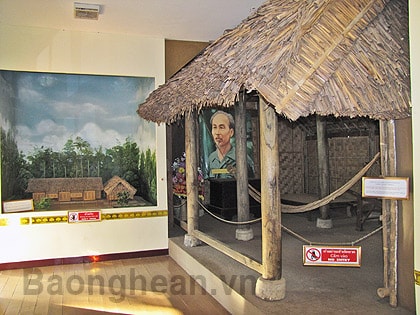Ban May remembers Uncle Ho
(Baonghean) -From the beautiful country of Laos, crossing the Mekong River, we went to Nakhon Phanom province, where Ban May is located, to hear stories about Uncle Ho, visit his house and see again the images of Sen Village and Tru Village right on Thai soil...
Nakhon Phanom is a province in northeastern Thailand, bordering Thakhek town of neighboring Laos.

Simulated image of Uncle Ho's Sen village in Uncle Ho's relic site in May village.
Mr. Hoang Van Phuc, over 80 years old, one of the prestigious Vietnamese people in the community in Nakhon Phanom province, said: Right from the time they set foot on this land, the first Vietnamese people chose a land with dense trees to live, because they were afraid of being chased away by the local government. This land was called by the Vietnamese people as Na Chooc village (land of "jackal dogs", because in the beginning, there were dense forests, wild fields and many wolves). With the hard-working and diligent hands of the Vietnamese people, this land gradually changed its skin and flesh and became the most important residential area of the Vietnamese community in Nakhon Phanom, a place to welcome revolutionary cadres from the country to Siam to work.
In July 1928, under the alias Thau Chin, leader Nguyen Ai Quoc came to Nakhon Phanom. Here, Thau Chin suggested that the villagers change the name from Na Chooc village to May village, meaning "new village", marking the renewal of the village established by the Vietnamese community. Initially, Thau Chin mobilized a number of young people in the village to cut wood and burn bricks to build a stilt house that served as a place to live, study and shelter for revolutionary cadres from within the country. He called this a cooperative house. The house faced Noong Nhat lake; in front of the house, Thau Chin planted a star fruit tree, two coconut trees and a hedge of hibiscus flowers,...
During this period, the Vietnamese in Siam did not know much about Thau Chin, they only saw him as an approachable man, very attentive to the people in all matters. Every day, after work, Thau Chin and other young men played soccer, taught people how to grow rice, grow potatoes, and save money to be ready to turn to their homeland and help the revolution. He advised overseas Vietnamese that wherever they went, whatever they did, they must always turn to their homeland.
Later, when the revolution succeeded, the people of May village knew that Mr. Thau Chin was the leader Ho Chi Minh. Since then, everyone cherished and respected the smallest souvenirs related to Uncle Ho during his time in May village. During his time in May village, Uncle Ho guided the people to learn Thai language to understand the customs of the neighboring country, but he also told the people to preserve the Vietnamese language and customs because he was Vietnamese.
Presently, Uncle Ho's house in May village is preserved quite intact by the people, with familiar objects that Uncle Ho used such as a hat, rubber sandals, a wooden bed, a rice warehouse, a cooking stove, a fishing basket, etc. This house was assigned by the local government and the community to Mr. Nguyen Trong Tieu's family to preserve, protect and receive guests, and tell stories about Uncle Ho. For the past two years, since Mr. Tieu passed away, his children and grandchildren have continued to do his father's work. Occasionally, when guests from the country come to visit, Vietnamese people come together to Uncle Ho's house to ask about his health and the situation in the country. For many people, they simply come to listen to Vietnamese, to ease their homesickness. When talking about Uncle Ho, the people of May village are moved and grateful. Many small stories of Uncle Ho during his days of activities in Siam are also preserved by the people of May village, passed down to future generations.
In May village today, in addition to Uncle Ho's stilt house, there is also the Vietnam - Thailand Friendship Village Relic Site and President Ho Chi Minh Memorial House. Here, the Vietnamese and Thai governments have jointly built models of Uncle Ho's paternal and maternal hometowns in Sen village (Kim Lien - Nam Dan) along with objects associated with Uncle Ho's activities in Thailand. These are familiar destinations for Vietnamese people living, studying and working in Thailand. Many Thai people have also come here to respectfully burn incense at Uncle Ho's altar.
Mr. Dao Trong Ly, Chairman of the Vietnamese Association of Nakhon Phanom Province, said: Currently, the Vietnamese community here has about 20,000 people, with about 300 households in May village alone. Every year, on Uncle Ho's birthday, the Vietnamese community in Nakhon Phanom gathers at the Association's headquarters to offer incense and flowers, report to Uncle Ho, and then go together to May village to visit the stilt house, visit the Friendship Village, visit the simulated images of Sen village and Hoang Tru village in the Uncle Ho relic site. "Although far from home, the image of Uncle Ho and the image of Vietnam are always in the hearts of every Vietnamese person in Thailand. May village is the ideal place to educate traditions, patriotism, and national pride for every Vietnamese person studying, working, and living in Thailand," Mr. Dao Trong Ly confided.
Article and photos: Nguyen Khoa
